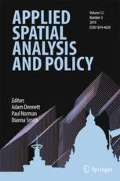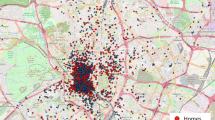Abstract
Prior weighted entropy functions compensating for the arbitrary partitioning by the zoning system of the origin and destination quantities in entropy maximising models of spatial interaction are presented and justified. This type of prior weighting is essential if the dual variables derived from the entropy maximising derivation of these models are to be used and interpreted as spatial prices in empirical studies. Failure to use prior weighted entropy functions taking account of varying zone sizes results in the biasing of dual variable values. Empirical illustrations of zone size biasing of house price and consumer welfare dual variable values are presented using a Herbert-Stevens model of a spatial housing market.


Similar content being viewed by others
References
Alonso, W. (1964). Location and land use. Cambridge: Harvard University Press.
Balinski, M. L., & Baumol, W. J. (1968). The dual in nonlinear programming and its economic interpretation. Review of Economic Studies, 35(3), 237–256.
Batty, M. (1974). Spatial entropy. Geographical Analysis, 6(1), 1–31.
Batty, M., & March, L. (1976). The method of residues in urban modelling. Environment and Planning A, 8(2), 189–214.
Boyce, D., & Williams, H. (2015). Forecasting urban travel: Past, present and future. Cheltenham: Edward Elgar.
Erlander, S. (1977). Accessibility, entropy, and the distribution and assignment of traffic. Transportation Research, 11(3), 149–153.
Evans, S. (1973). A relationship between the gravity model for trip distribution and the transportation problem of linear programming. Transportation Research, 7(1), 39–61.
Kullback, S. (1959). Information theory and statistics. New York: Wiley.
Openshaw, S. (1977). Optimal zoning systems for spatial interaction models. Environment and Planning A, 9(2), 169–184.
Senior, M. L. (1979). From gravity modelling to entropy maximising: a pedagogic guide. Progress in Human Geography, 3(2), 175–210.
Senior, M. L., & Wilson, A. G. (1974). Explorations and syntheses of linear programming and spatial interaction models of residential location. Geographical Analysis, 6(3), 209–238.
Snickars, F., & Weibull, J. W. (1977). A minimum information principle: theory and practice. Regional Science and Urban Economics, 7(1–2), 137–168.
Stevens, B. H. (1961). Linear programming and location rent. Journal of Regional Science, 3(2), 15–26.
Stillwell, J., Bell, M., Ueffing, P., Daras, K., Charles-Edwards, E., Kupiszewski, M., & Kupiszewski, D. (2016). Internal migration around the world: comparing distance travelled and its frictional effect. Environment and Planning A, 48(8), 1657–1675.
White, H. P., & Senior, M. L. (1983). Transport geography. Harlow: Longman.
Williams, H. C. W. L., & Senior, M. L. (1977). Model-based transport policy assessment 2. Removing fundamental inconsistencies from the models. Traffic Engineering & Control, 18(10), 464–469.
Williams, H. C. W. L., & Senior, M. L. (1978). Accessibility, spatial interaction and the spatial benefit analysis of land use-transportation plans. In A. Karlqvist, L. Lundqvist, F. Snickars, & J. W. Weibull (Eds.), Spatial interaction theory and planning models (pp. 253–287). Amsterdam: North-Holland.
Wilson, A. G. (1967). A statistical theory of spatial distribution models. Transportation Research, 1(3), 253–269.
Wilson, A. G. (1970). Entropy in urban and regional modelling. London: Pion.
Wilson, A. G. (1971). A family of spatial interaction models and associated developments. Environment and Planning, 3(1), 1–32.
Wilson, A. G. (1976). Retailers’ profits and consumers’ welfare in a spatial interaction shopping model. In I. Masser (Ed.), Theory and practice in regional science (pp. 42–59). London: Pion.
Wilson, A. G., & Senior, M. L. (1974). Some relationships between entropy maximizing models, mathematical programming models and their duals. Journal of Regional Science, 14(2), 207–215.
Wilson, A. G., Coelho, J. D., Macgill, S. M., & Williams, H. C. W. L. (1981). Optimization in locational and transport analysis. Chichester: Wiley.
Author information
Authors and Affiliations
Corresponding author
Ethics declarations
Conflict of Interest
The authors declare that they have no conflict of interest.
Rights and permissions
About this article
Cite this article
Senior, M.L., Williams, H.C.W.L. The Varying Zone Size Effect and Dual Variables for Entropy Maximising Models of Spatial Interaction. Appl. Spatial Analysis 11, 657–667 (2018). https://doi.org/10.1007/s12061-018-9277-3
Received:
Accepted:
Published:
Issue Date:
DOI: https://doi.org/10.1007/s12061-018-9277-3



